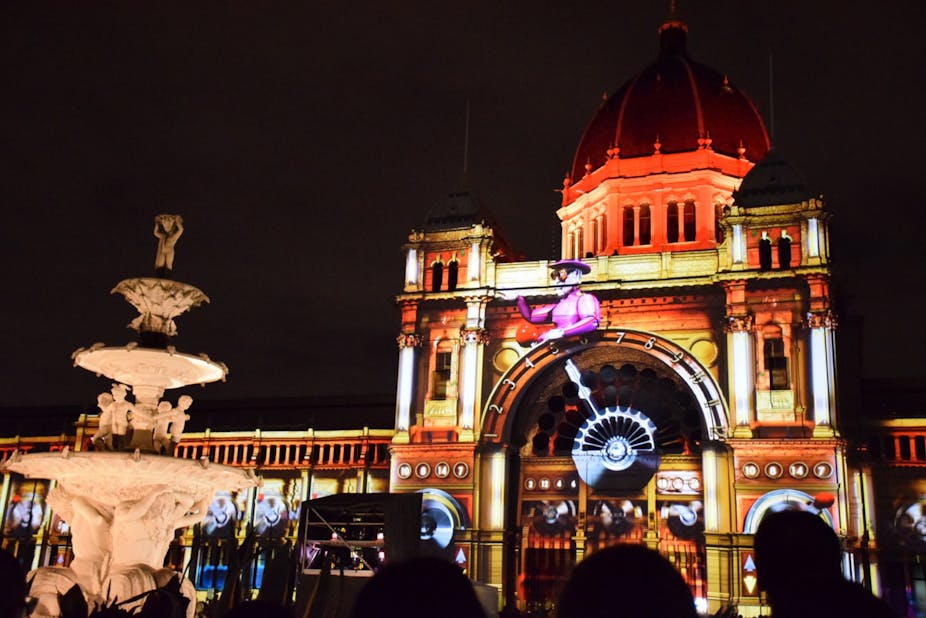Last week it was White Night in Melbourne. I’m embarrassed to say I was tucked up asleep in bed (it had been a long week!). But my Instagram feed attests that the architectural community, along with several hundred thousand of their friends, were out all night prowling the streets, marvelling at the spectacle of a city shown in literally a new light.
Since then, I’ve been thinking about it, and it strikes me that it’s not just the city recast by White Night, there’s something interesting about how architecture is “brought to life” by this event, and other similar ones – the Vivid Festival in Sydney is an obvious example, but I think the phenomenon also includes the various Open House events around the country. These kinds of events have the curious effect of making people look at buildings: specifically, directly, intently, and in a way that is very different from what they do in the everyday.
Of course, White Night is about more than just projections onto buildings: it includes all manner of “installations, lighting, exhibitions, street performances, film, music, dance and interactive events”. But to my eye the projections are the main game: the most spectacular, the most transformative, and they’re certainly the most interesting in terms of how they reframe an audience’s relationship to architecture.
Apart from architects, it’s usually only tourists who pay particular, close attention to buildings, as a category of objects. When visiting a strange city, it’s not unusual for regular people (that is, non-architects) to visit a “blockbuster” museum building, or a cathedral, for the sake of the architecture alone.
In unfamiliar cities, we walk through the old town and marvel at the crooked walls, the patinated doorways, the wobbly glass in the windows – we actually look at buildings, as objects or subjects in themselves. But for people who live in that city, familiarity means its buildings have usually sunk beneath notice – taken for granted, they become simply part of the urban furniture.
The distinction between these two viewpoints was famously articulated by the theorist Walter Benjamin. He wrote that architecture represents an art form whose reception “is consummated by a collectivity in a state of distraction”, where buildings are apprehended “much less through rapt attention than by noticing the object in incidental fashion”.
Benjamin’s argument goes like this. Buildings are understood and “appropriated” by people “in a twofold manner: by use and by perception – or rather, by touch and sight”. So, people use buildings, and, along with other people, they wander within and amongst them, and most of all they integrate buildings into their lives, making them habitual. But in that process, they no longer see them.
Such a “tactile” familiarity with buildings is thus the polar opposite of the “attentive concentration of a tourist before a famous building”, as Benjamin puts it. Someone who deliberately looks at buildings is quite the opposite to someone so familiar with a building that they no longer notice it is there.
It is this latter group whom Benjamin describes – admiringly, it should be said – as apprehending buildings in a state of distraction. He sees this as the “prototype” for the “absent-minded” reception of other works of art – particularly film – after the decline of art’s “aura”, in an age of mass consumption and mechanical reproduction.

There is much more to Benjamin’s essay, and his argument, but for my purposes here the concept of distraction is the key one: White Night, and the other events and festivals of its ilk, transform those people who have already habituated and “absorbed” the buildings of the city, back into an active audience. No longer “distracted” in Benjamin’s sense, they have the “rapt attention” of tourists, whether they live locally or not.
And all this is what makes the trend towards the so-called “festivalisation” or “eventification” of cities so interesting: it constitutes (if only temporarily) an attentive audience for architecture. It’s not a new idea that as tourists and residents alike, we are now all agog at the staged urban theatre of the experience economy, that we are consuming the city as a place, at the same time as consuming its experiences and commodities and images.
But when the city becomes an event, it also (temporarily) changes the temporality of buildings: it shifts them from the slow, long duration that is their usual state, and makes them mutable, fast, current, of the moment.
Buildings are (temporarily) changed from being seemingly timeless objects, to being timely, staged, theatrical performances, flickering and glimmering in the night.

